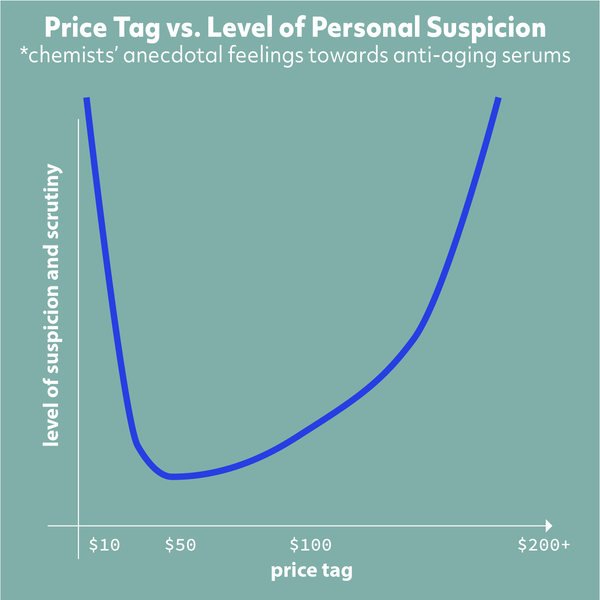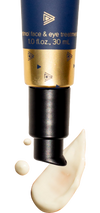So you're ready to tackle some pesky wrinkles eh? Don't worry, the chemists gotchu! The good news is that the skin concern of wrinkles is probably one of the more well-studied aspects in skincare science (even down to the physics and modeling of wrinkle formation!). As a result, more ingredients have been tested in this category than many other areas of skin concern, which is both good and bad. There are a lot of ingredients options to try, but it still requires some sifting through the foo-foo stuff. Sadly, this category is where you’ll find some of the most expensive products, but that's why you have us to arm you with knowledge! and lead you to the true wrinkle fighters!
First Things First! A Review On Wrinkle Biology
Most of the time when you hear about anti-wrinkle claims, you’ll run across the terms, collagen & elastin. Collagen is a triple helix protein that makes up roughly ~75% of the dry weight of our skin, while elastin is a minor component in the skin, but both are key in the overall integrity of the structure of the skin. In fact, collagen is what gives skin its tensile strength, while elastin gives skin its elasticity & ability to bounce back.

The issue with honing in on collagen and elastin is that they are actually end products in the whole cycle of skin aging. So let’s go back in time (pun intended) to the catalyst of wrinkle formation, dermal fibroblasts, cells that actually create your structural proteins. Your fibroblasts secrete precursors, such as procollagenase & tropoelastin, which act as the building blocks that are cross-linked to make collagen & elastin. Collagen has a unique life span. For example, the most abundant collagen in your skin collagen-1 has a lifespan of ~30 years and then are replaced. However, as you age, a build-up of modifications and cross-links occurs with the old collagen, forming collagen fragmentation. These become big obstacles for fibroblasts. The sites are important because fibroblasts can attach, stretch out, and happily signal for procollagen production, but these sites become lost to collagen fragmentation. Lost sites inevitably lead to lost tensile strength & elasticity which makes skin more prone to wrinkle formation.
Wrinkle formation is spurred by two separate factors: intrinsic aging (aka. Father time & genetics) and extrinsic factors such as UV damage, smog, cigarettes, stress, inflammation, and even dry skin. All factors that aren’t always in our control, luckily there are many topicals that can be incorporated as preventative care and actively combat wrinkles.
Meet The Players

- Sunscreen: One of the main external causes of wrinkle formation is sun damage. In fact, it’s such a major factor in skin aging it has its own name - photoaging. But you already know that. And you probably already know to use sunscreen right? RIGHT? Moving on.
- A Solid Moisturizing Strategy: this may sound basic, but keeping skin happily hydrated is a key part of wrinkle prevention. Don’t just hear it from us, a Korean lab looked at multiple variables and their contribution to wrinkle formation in 97 healthy women of varying ages, and found that skin hydration had a direct correlation to wrinkle formation. When skin is hydrated, its water-swollen elastic fibers gain their elastic recoiling ability minimizing skin’s tendency to repetitively fold and create a wrinkle.
- AHAs: Regular cell turnover plays an integral part in maintaining healthy skin and preventing skin from developing rough, scaly, dry skin.
- Antioxidants: Part of the reason UV damage is so detrimental is the ability to generate free radicals in the skin, which leads to collagen & DNA damage, and even cell death. Antioxidants help to quench free radicals and protect skin from the chaos it can cause.
- Ascorbic Acid (Vitamin C): The antioxidant with the most robust data in quenching free radicals in skin is Vitamin C molecule, ascorbic acid. There are studies that have shown good ol’ ascorbic acid can minimize damage from UV-induced sunburns.
- Non-Ascorbic Acid, Vitamin C Derivatives: if ascorbic acid doesn’t work for your skin, consider a Vitamin C derivative such as ascorbyl glucoside, magnesium ascorbyl phosphate, sodium ascorbyl phosphate, and THD ascorbate. Although these don’t have the same robust antioxidant data as ascorbic acid, the data that exists on these guys are better than most.
- Other Plant AOX: This can be the wild wild west, but head to our dedicated blog article to find other alternative antioxidants.
Active Wrinkle Fighters: Here we breakdown the general ingredient landscape and how to organize these when it comes to building your skincare routine strategy.
- Tried & True: These are ingredients that have been tested and validated time and time again as worthy wrinkle fighters.
- Retinoids - Probably the oldest trick in the book is retinoids, because they work. 0.025-0.1% tretinoin, 0.3% adapalene, 0.1-1.0% retinol, 0.05 - 0.1% retinaldehyde, and even plant-based bakuchiol all have data in wrinkle reduction. The issue with retinoids is the onboarding process. Checkout our dedicated post to see how to best integrate a retinoid in your routine.
- Ascorbic Acid (Vitamin C) - You read correctly, we’re talking about ascorbic acid twice today. We rave about ascorbic acid because not only does it have solid data as an antioxidant, but also in promoting collagen synthesis. Even just 3 - 5% ascorbic acid was found to help reduce wrinkles after 12 weeks and 3 months respectively.
- Awesome Secondary Players:
- Tried & True Peptides - The peptide library is massive and mysterious! We recommend sticking to traditional peptide blends like Matrixyl 3000 which has been validated and revalidated as wrinkle fighters. Also, keep in mind, not all peptides are wrinkle fighters, so definitely keep that in mind as you shop for your next peptide product.
- Higher Concentrations of Glycolic Acid - That’s right, introducing weekly wash-off AHA peels with strengths of up to 30% (keep it to a pH of ~3.5) can help tackle bigger issues like wrinkles and pigmentation. Consider a higher strength in-office peel for deeper wrinkles.
- Niacinamide - You thought niacinamide was just for your oily skin and skin barrier healthy, but it’s actually also been tested (n=50) and found that at 5% it can reduce fine lines and wrinkles after 12 weeks.
- Other nice adds but not a must:
- Adenosine - We won’t get into this ingredient too much but basically there’s a patent turf war on this ingredient for its anti-aging properties (a snippet of drama for your enjoyment). You’ll find it sprinkled into all sorts of brands. The mechanism isn’t completely well understood but this nucleoside has been suggested to promote skin cell renewal and has been linked to improving periorbital wrinkles and even frown lines. Think of it as a nice bonus
- Exotic plant extracts! This one is hard, you’ll usually hear about them as the claimed, “story” active with a mysterious, whimsical background. If there’s a clinical on the formula, great! If not, look for other active sidekicks in the IL to help boost its wrinkle-fighting power. Example below of a marketed “tea” anti-aging cream with a bolstered ingredient list
A Couple Notes on Shopping for Anti-Aging Stuff
Probably one of the more frustrating aspects of this category is that the price range can go from $8 to $800. Our word of advice here is that as the price tag goes up, your level of detective work, suspicion, and investigation should also go up. We ourselves recommend not paying more than $200 for any formula. And anything in the $100 range, we’re looking for some solid clinical test to go along with it.

Also, remember that all good skincare needs time to work, especially when it comes to minimizing unwanted wrinkles. Nothing erases wrinkles overnight. Think of it this way, your skin is working to reduce its actual surface topography, while still functioning normally to protect your insides from all the foreign external bad guys. That’s a lot of work! Most clinical studies will give products at least 4 weeks (most likely using the product twice a day) to see any sort of result. Patience and consistent use are key here.
Takeaways
- Wrinkles are caused by both intrinsic factors (father time, genetics) and extrinsic factors (UV damage, free radical damage from cigarettes and smog, dry skin, and inflammation).
- Wrinkles is one of the more well-studied categories in skincare with a variety of skincare ingredients that have been tested to combat this skin concern.
- As a starting strategy, we recommend pairing preventative care (sunscreen, AOX, and good moisturizing habits) with a main wrinkle fighter such as retinol.
References
https://pubmed.ncbi.nlm.nih.gov/3745952/
https://www.ncbi.nlm.nih.gov/pmc/articles/PMC5064677/
https://onlinelibrary.wiley.com/doi/10.1111/j.1600-0846.2012.00650.x






